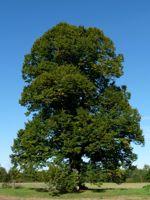Mon-Fri 9am - 5pm Mountain time
Common Hackberry vs Large Leaf Linden
Celtis occidentalis
Tilia platyphyllos
NOT AVAILABLE THIS SEASON - MIGHT RETURN
The Common Hackberry is a medium-sized deciduous tree that resembles the American Elm but is immune to Dutch Elm Disease. They are versatile and can adapt to a variety of growing conditions.
It produces purple-red, berry-like fruit with a large seed in the center. Both the sweet flesh, which tastes similar to dates, and the crunchy seed are edible. The fruit remains on the tree throughout the winter, offering a valuable food source for birds and other wildlife.
The Common Hackberry can also be a great addition to a pollinator garden. The tree itself is a host for the larvae of several butterfly species and the flowers provide a source of pollen and nectar.
Large Leaf Linden is a tall, deciduous tree native to Europe. Large Leaf Linden features oblong leaves that turn from yellow-green to brilliant yellow in the fall. Large Leaf Linden is ideal as a shade or ornamental tree in a larger yard.

